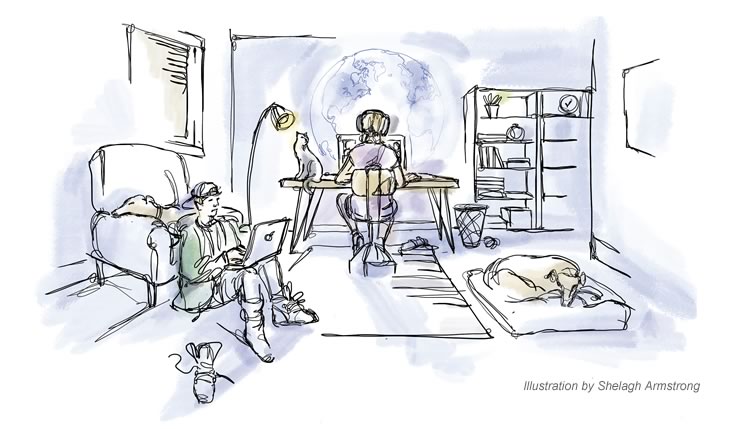A Time for Listening
Covid has forced us to work in new ways amid absurd family pressures. But coincident with the pandemic, we have been also confronting broader issues.

Sometimes we describe our eyesight as “laser-focused.” Lately, I’ve been finding it’s my ears that are laser-focused.
It started during the pandemic. Perhaps it was the need to really take in as much as I could from the person on the screen, who was just 14 inches from my face, but 70 kilometres away. I needed more information to understand the context of their words than ever before. I was finding it hard to tell if someone stiffened up in response to what I was saying, or if their legs were shaking under the table because they were nervous. Were they sweaty and rushed because they’d been chasing their kids or dog, or tending to an elderly parent, just before they came on screen? Or because they were uncertain about how to get through the mountain of sometimes traumatic work ahead of them? I couldn’t tell. Many people keep their cameras off. Can we blame them?
In our controlled, pre-pandemic office environment, communications were more predictable. Mostly everyone was calm. When they were happy and excited, it stood out, same when if someone was even slightly agitated – and all of it was in the context of work. Someone rushing to my desk meant they had important work-related news and we had a problem to solve. How someone walked into a room revealed a lot. I knew what was up.
Like us, kids have experienced a disconnect with the move to online schooling. How do they know if they’re doing a good job? When is the teacher leaning in on a certain subject, forcing their marker across the whiteboard with skippy squeaks of excitement? There haven’t been the small, individual nods of approval during the past year and a half, or conversely the ability for a teacher to spot red-faced anxiety and hold someone after class for a chat. Students’ screens were mostly nulled, teachers exasperated, and kids lost in the in-between internet ether.
It’s hard to grasp the full meaning of what is being “said” when we aren’t face to face. When I see the ALL CAPS MESSAGES sent to my son, Adrian, from his teacher, they “sound” like shouting – not really acceptable communication no matter how frustrating the situation.
“That frustration is about the entire system, the entire class being disengaged behind their screens,” explains the teacher when I ask him what the text exchanges are all about. “I’m at my wits’ end,” he admits. I’m sure Adrian has missed much of the opportunity to learn from his smart and capable teachers by literally not having the full picture. During the pandemic he’s gravitated to in-person learning when he’s been able, albeit from the far back corner. It’s who he is. A listener and an observer.
On the other hand, juxtaposed with the lack of holistic information and the ability to read the room, there is a new dimension to knowing our colleagues or schoolmates or leaders. In the past, for the most part, our outside world didn’t intrude on our 9-to-5 lives. No home chaos around us; it was mostly packed away for the day. Now, from time to time, babies squawk, dogs woof and we see messy counters and beds – glimpses of real life undermining carefully cultivated professional veneers.
Covid has forced us to work in new ways, and absorb these absurd family pressures. But coincident with the pandemic, we have also been confronting the horrors of racism, genocide and global inequities. Listening more intently can feel very confusing and overwhelming, but it has helped me try to unravel the personal histories that might be underlying the words of the people I’m listening to – the pains, joys or complicated, generational traumas.
Who says what and how they say it carries more significance than before. Sometimes, through the pandemic, we have heard voices not heard clearly in the past – Indigenous and Black people, women, nurses, vulnerable workers, scientists. So I’m listening to who is speaking in a meeting, but I’m also listening to those who are silent, and wondering if some larger social trauma has affected their confidence to speak up.
I’m listening hard and trying to watch my own words at the same time. I’m watching faces closely when I can on my screen, asking a follow-up question, reaching out by text or phone call after a meeting to make sure I understood and what pieces I might have missed. I listen for tone. I close my eyes and picture each person listed on the screen – their faces, imagining how they might react. If the screen is silent when I’m leading a team meeting, I realize I might have misstepped. “What did I say? Help me understand,” I ask my trusted friends and colleagues.
“We are all just tired of listening, to be honest,” my one teammate says. I agree. It’s a lot, but we all have to keep trying.
As I write this, we are preparing for the school year again, and I hope Adrian will be back in the classroom – science and society willing. We will all keep trying new ways of listening, students that we all are. “Be patient and keep trying. Keep listening in all its forms,” I say to him.
More Info
Indigenous Culture in Dufferin
Dufferin County Cultural Resource Circle is an Indigenous-led, not-for-profit organization that aims to create a safe space for the restoration and revival of traditional Indigenous culture in the county. dufferincountyculturalresourcecircle.org
Honouring Indigenous Children
In honour of Indigenous children found buried at former residential schools, the DCCRC invites you to visit the Mino Kamik Medicine Wheel Garden for reflection. When you visit, you may see chalk outlines of feet — these outlines represent children found and the many others lost in residential schools — and you are welcome to add your own. You can leave a pair of children’s shoes or moccasins in commemoration, or contribute stones painted orange as you reflect with your children at this site. Did you know that medicines in the garden may be harvested responsibly for free to use for smudging? This is a special site and worth a visit. The medicine wheel garden is located in Bravery Park behind the Alder Rec Centre in Orangeville.
Orange Shirt Day is September 30
Orange Shirt Day, coinciding with the new National Day for Truth and Reconciliation, is an opportunity to create meaningful discussion about the effects of residential schools. It’s a time for listening and supporting the Indigenous community. Watch for recognitions here and across Canada. orangeshirtday.org
Our Diverse Communities
Diversity, Equity and Inclusion committees are doing good work in the hills. We have a long way to go — and reading up, following and supporting this work is important for our families and communities to be vibrant and welcoming to all. Here are a few places this work is being done:
Shelburne’s Anti-Black Racism, Racism and Discrimination Task Force has set out a blueprint to address racism and discrimination in the community; read the recommendations and meeting updates online. shelburne.ca
Orangeville is developing a work plan through their Equity, Diversity and Inclusion Committee. They act as an advisory body to town council on matters related to diversity, equity and inclusion, and work to break down barriers for all. orangeville.ca
Dufferin County’s Diversity, Equity and Inclusion Community Advisory Committee has a similar mandate to Orangeville’s — to advise county council, make recommendations, and provide a monitoring and measuring role to help ensure the county applies a diversity, equity and inclusion lens to its policies, services and programs. dufferincounty.ca
Peel Region’s Diversity, Equity and Anti Racism (DEAR) Committee is working to remove systemic barriers and address racism in one of the most diverse regions in Canada. The work of this committee is focused on adopting an intentional approach to equity in programming and service delivery. peelregion.ca/diversity








